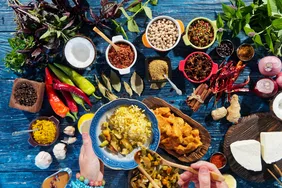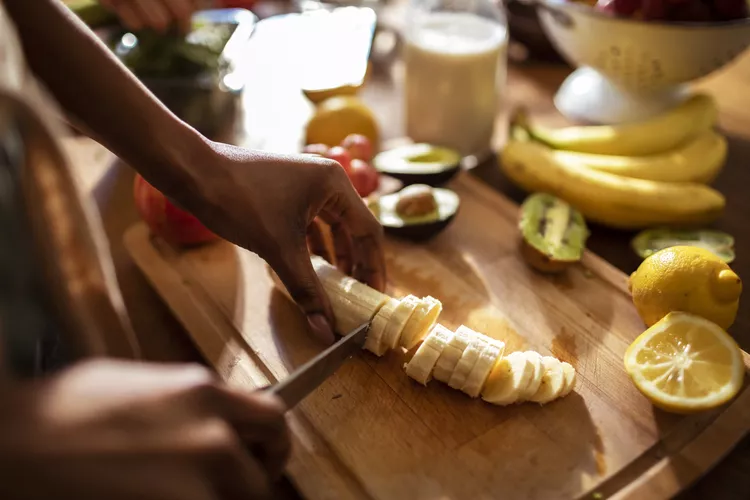The online weight-loss space has actually seen a resurgence of a popular weight management approach– volume consuming.
Whether you’re scrolling through TikTok and Instagram or reading your local news, it’s difficult to avoid pointers and techniques for the next magic bullet to reduce weight. There will always be a new trend, brand-new product, or new practice that encourages you to offer it a try in the name of weight-loss.
Or, sometimes, an old concept will resurface. Such is the case with volume consuming.
Volume eating is a dieting principle or technique of eating that focuses on consuming larger amounts of food that are low in calories.
According to Jamie Nadeau, RD, “The idea behind volume consuming is that the larger physical amount of food will keep you fuller. Volume eating enables you to consume a large quantity of food while still remaining in a calorie deficit if you’re working toward weight-loss.”
We spoke with signed up dietitians, professionals in food and nutrition, to weigh in volume eating, what it’s everything about, and the advantages and disadvantages of trying it for weight-loss.
How Volume Eating Works
Volume consuming is a way to consume more food without increasing calorie intake too much. This works because the calorie content of food is figured out by its macronutrient content.
Gram per gram, various macronutrients provide a various variety of calories. For instance, there are 4 calories in one gram of carbohydrate and protein and 9 calories in one gram of fat.1.

What foods are thought about high-volume and low-volume?
Low-volume foods contain more calories per gram, which indicates that a small amount of food provides a great deal of calories. Some examples of low-volume foods include high-fat foods like oils, nuts, cheese, and high-sugar foods like dried fruit or juice, and maple syrup or honey.
In contrast, high-volume foods load a great deal of fiber and water and supply much fewer calories per gram. Some examples of high-volume food consist of veggies, high-fiber fruits, like apples and berries, oatmeal, and eggs. When consumed in volume, high-fiber and water foods keep you more complete with fewer calories.
Volume consuming, when done appropriately, can be handy for some people to reduce weight. Focusing on nutrient-dense entire foods assists keep you full and pleased for longer given that these foods rather literally fill up your stomach more.
Volume Eating for Weight Loss.
If you have an objective of weight reduction, volume eating can be a valuable method to handle calories without in fact having to count calories.
In volume eating, having a large amount of food on your plate doesn’t necessarily imply more calories– this is great news if you are trying to maintain a calorie deficit. When carefully planned, volume consuming can increase the overall nutrient density of your diet plan, given that you are focusing primarily on vegetables and fruits. Volume eating can be a good way to improve the fiber, vitamins, minerals, and antioxidants in your diet.
” Volume consuming is just healthy and helpful if you’re still getting all the nutrients you require throughout the day,” warned Kelsey Kunik, RDN and nutrition consultant for Fin vs Fin.
It is important to ensure you are consuming a variety of foods which contain sufficient carbohydrates, protein, fat, and fiber and not only eat foods since they are low in calories.
” If someone is attempting to utilize volume as a technique for getting complete, it’s crucial to bear in mind that volume can only go so far in terms of fulfillment,” Nadeau added. “A big piece of fulfillment is flavor and preference. If you’re eating a big volume of foods just due to the fact that they are low calorie, you are most likely to find yourself having lots of cravings and perhaps even overindulging or bingeing at nights.”.
Common Volume Eating Mistakes.
While volume consuming may appear like a simple way to lose weight, there are numerous ways it can be done incorrectly and perhaps cause more damage.
Volume consuming might fail when somebody is only focusing on the actual volume and not on the total range of foods they are eating.
Nadeau alerted, “The least expensive calorie isn’t always the very best choice, and volume consuming motivates you to pick a great deal of lower calorie foods merely due to the fact that they fit easier into a calorie deficit. Errors made normally consist of not consuming enough calories, protein, fat or not focusing on foods individuals really delight in eating.”.
Considering that fats have the most calories per gram, individuals may choose to prevent them. However fats play a large function in the complete satisfaction of a meal, in addition to the incredibly important health benefits they supply such as the absorption of fat-soluble vitamins, anti-inflammatory homes, and regular cell and nerve function.2.
Volume consuming can have some more immediate health effects too.
Kunik added that “high-volume eating can result in bloating and digestion pain, as lots of high-volume, low-calorie foods are high in fiber. Too much fiber from raw vegetables and fruits can cause gastrointestinal upset and micronutrient shortages.”.
More serious repercussions can occur gradually when volume eating can quickly turn into disordered eating without a focus on balanced nutrition and overall health.
” Volume consuming encourages great deals of low-calorie foods, which can contribute to cravings, overeating, continuous food ideas, and bingeing,” Nadeau explained.
If you observe yourself feeling out of control around foods, constantly thinking of food or bingeing, make certain to pause volume eating and always look for aid from a registered dietitian for guidance and support.
If volume consuming is done too aggressively or obsessively, it won’t be sustainable in the long term. Nadeau recommended “focusing on satiating foods that you take pleasure in at your meals like protein, fiber, and vibrant vegetables and fruits” instead of just narrowing in on the volume of food you’re taking in. This permits your focus to move to a more sustainable, healthy approach to your diet.
As holds true with any new dietary routine, it’s wise to examine where you are getting your nutrition advice from before diving in. Online influencers providing advice about volume consuming might not be the most sound, evidenced-based source to get your nutrition details. If you have any issues, questions, or notice yourself starting to consume over food volumes, seek counsel from a signed up dietitian.


